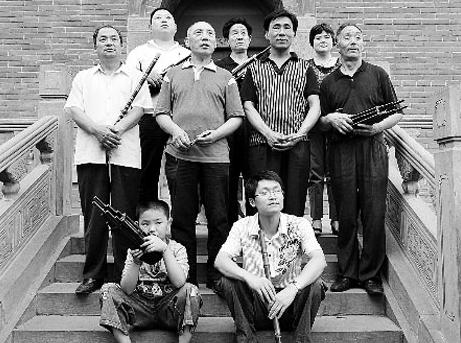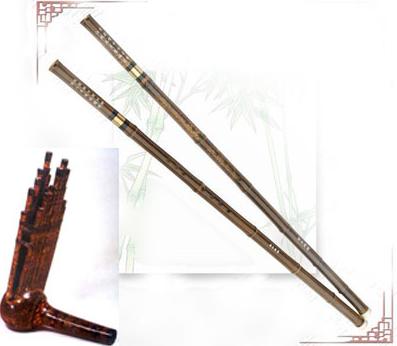
Chuige is a very ancient Chinese performance form with wind instruments among which pipe is the principal one supplemented by sheng, flute, xiao (a vertical bamboo flute), drum, big cymbals, and finger cymbals, etc. It can be rated as symphony of ancient China. Originating possibly from the Shang dynasty, Chuige has a history that can be traced back to nearly 4000 year ago. According to the Annals of Mi County, Chaohua Chuige inherited features of imperial music of Tang and Song dynasties. During the Jingtai period of the Ming dynasty, a member of the Imperial Academy retired in his old age and returned to Mi County, his ancestral home. During his visit to Chaohua Temple, "the 15th famous ancient temple of China", he imparted the skills of Chuige to the monks. The skills were taught to common people by the monks during the late Ming dynasty. Afterwards, the Society of Chaohua Chuige became a folk organization of literature and art, and has been passed down from generation to generation for more than 500 years by far.

The principal instrument used in Chuige is a pipe which, according to Lexic Sea, (an encyclopedia in Chinese), appeared in Shang Dynasty and is mainly made of wood and bamboo. The pipe used in Chaohua Chuige, however, is finely cast from pure brass. It is a mystery how the pipe is made because the technique has been lost and become non-reproducible. That’s why the pipe is called "the living fossil of ancient Chinese folk music instrument" by experts. Chaohua Chuige requires two pipes in performance, one for treble and one for bass. This is distinct from other Chuiges throughout China. The pipe is 16cm long, and wide on the upper part and narrow on the lower part rather than narrow on the upper part and wide on the lower part like traditional pipes. The front of the pipe has 7 holes and the back one. Each hole can make three sounds that vary in pitch with the force. The wide end of the pipe has a 4cm mouthpiece of reed. In the Chuige team, there is also the ancestral 18-miao sheng which looks like yu of the Spring and Autumn period. 18-miao means that the sheng is made up of 18 bamboo pipes.

The "oldest" part of Chaohua Chuige is that the melodies are recorded with the ancient Gongche notation, i.e. the "gong, shang, jiao, zhi, yu" in ancient music. The over 30 qu tunes for Chaohua Chuige that have been passed down are mostly recorded with the Gongche notation which is a very rare existent system of musical notation in China, so Chaohua Chuige is referred to as the "living fossil of ancient music" by music experts.

During the Jingtai period of the Ming dynasty, Chaohua Chuige was introduced to temples from the imperial court. It then became an exquisite band that served folk shrine organizations. Chaohua Chuige used to be passed down in the same clan. From the 6th generation, it began to be inherited in the same agricultural community, and people outside the Song clan were absorbed. The present members of the Chuige team are chiefly the 11th generation. A few belong to the 10th generation. Chaohua Chuige follows strict principles. It never serves weddings and funerals. It is reserved only for visits to friends, fetes, religious ceremonies, temple fairs, and entertaining activities.





